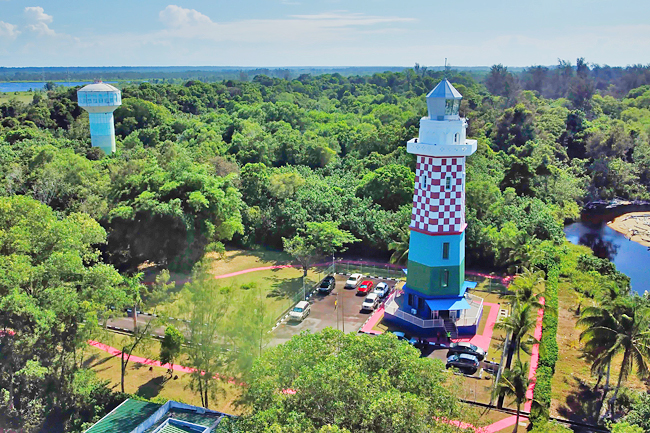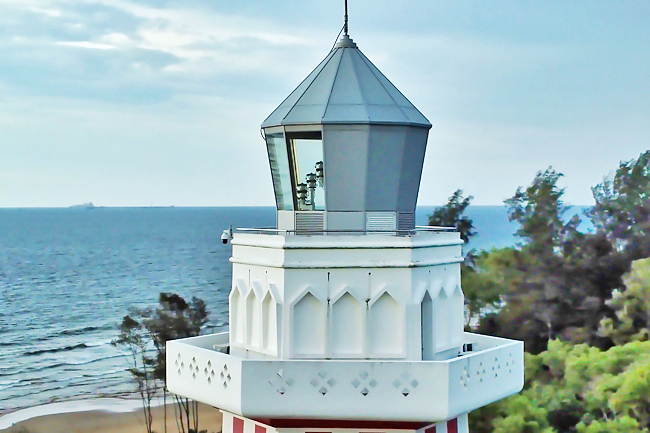It’s worth noting that the Belait District occupies a unique space, boasting a wealth of iconic landmarks that span from the visionary science education centre of Seria Energy Lab to the nearby recreational park, historical monuments and buildings that have stood the test of time, such as that of the Billionth Barrel Monument and the Belait District Museum.
There is one site, however, that is not widely known, but plays an equally vital role, especially in the world of maritime travel.
The humble lighthouse that sits hidden off the coastline along Kampong Lumut stands as an enduring symbol of maritime safety and navigation, and it proudly holds the distinction of being the only lighthouse of its kind in the country.
The ancient Egyptians are credited with pioneering the historical role of lighthouses, as they were the first to employ rudimentary beacons to safely guide ships into Alexandria’s harbours.
These initial endeavours involved the utilisation of bonfires and basic towers equipped with open flames that emitted a flickering light discernible from afar. As maritime trade and exploration evolved, so did the need for more reliable and consistent navigation aids and throughout the centuries, lighthouse design and technology evolved.


Especially with the continued advancement of modern navigational tools such as the global positioning satellite or GPS, radar, electronic naval charts and more, one might wonder if these towering beacons still hold relevance in an age of GPS and advanced navigation technology.
Instead, it would be more relevant to reframe the question with a focus on eliminating redundancy and enhancing reliability.
Under the administration of the Maritime and Port Authority of Brunei Darussalam (MPABD), the lighthouse dates back to 2004, built on November 4 at a cost of BND937,212.08.
The lighthouse, serving as a guiding light for vessels, was visited by His Majesty Sultan Haji Hassanal Bolkiah Mu’izzaddin Waddaulah ibni Al-Marhum Sultan Haji Omar ‘Ali Saifuddien Sa’adul Khairi Waddien, Sultan and Yang Di-Pertuan of Brunei Darussalam on May 23, 2006.
At the height of 32 metres, the imposing structure is adorned in red, white, and blue, symbolising the nation’s presence on the global maritime platform.
Despite the emergence of cutting-edge navigational technologies like radar, GPS and satellite-based systems, which have considerably enhanced the safety and convenience of maritime travel in contemporary times, the lighthouse continues to fulfil the role as a guiding beacon for navigation.
This encompasses the aspect of serving as a dependable source of information.
While GPS systems offer a high degree of accuracy, they are susceptible to technical malfunctions or signal disruptions. Lighthouses serve as a dependable fall-back, allowing mariners to cross-verify their positions and maintain secure navigation.
The mighty beam emitted from the lighthouse can also help in foggy or stormy conditions where visibility can be severely limited.
Furthermore, the lighthouse also provides the average seafarer with a navigational tool that is always reliable, especially for those who have limited access to modern navigational technologies such as GPS. As such, lighthouses offer a crucial reference point for vessels lacking sophisticated equipment.
While the thought of a lighthouse might conjure up the classic rotating platter with a singular lightbulb in the middle, the lighthouse in Lumut has been modernised with light-emitting diode (LED) lighting.
The days of using traditional open flames are long gone, replaced by electric lights, and even those have been substituted with energy-efficient LED bulbs. It’s interesting to note that these LEDs have not only heightened the brightness and efficiency of lighthouse beams but have also led to decreased maintenance expenses and a reduced environmental footprint.
While we sail through the contemporary age of maritime navigation, equipped with an array of technological tools, it remains vital to acknowledge the timeless importance of lighthouses.
They serve not only as guiding beacons but also as symbols of unwavering strength, dependability, and the enduring bond between humanity and the sea.
As long as ships sail the oceans, these timeless guardians of the coast will continue to play a crucial role in ensuring safe passage, honouring their storied past while embracing the promise of the future. – Daniel Lim


